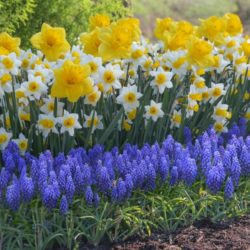The first crocus or tulip poking through the ground, sometimes before the snow has fully melted, symbolizes spring for most of us. Before most other flowers have revived, spring bulbs can provide you with vibrant, cheery color just when you need it most and best of all bulbs can bloom year after year. A little effort now will reward you with a colorful display just when you need it most.
Daffodils are a wonderful plant because they are resistant to deer. If you get frustrated when the deer come and eat your tulips right when they start to flower then daffodils are the answer. Their beautiful trumpet flowers are just as beautiful as tulips and you get to enjoy them instead of the deer.
Allium is one of the most beautiful spring flowering bulbs. I had a garage sale when my alliums were blooming and it seemed like every person to stop had to stop and check them out! One guy even had to touch them since he didn’t think they were real!
Planting bulbs is fast, easy and nearly foolproof.
Fall-planted bulbs need to establish their root systems when the ground is cool so they can provide the biggest, most colorful flowers in the spring thaw. The good news is that planting flower bulbs is fast, easy, and nearly foolproof.
When to plant Bulbs should be planted as soon as the grounds cool. In most parts of the country, this would be around the time of the first frosts, when evening temperatures average between 40 to 50 degrees F. But you must plant at least six weeks before the ground freezes. You can, if necessary, store bulbs for a month or longer, if you keep them in a cool dry place. When in doubt, however, the bulbs belong in the ground. They won’t last till next season.
Read the label. They usually come with instructions. Read them. And keep the label together with the bulbs until planting. Without the label, you can’t tell the red tulips from the white ones just by looking at the bulbs.
Where to plant. You can plant bulbs just about anywhere in your garden long as the soil drains well. The Dutch say, “bulbs don’t like wet feet.” So, avoid areas where water collects, such as the bottom of hills. Bulbs also like sun. But the spring garden is very sunny – the leaves aren’t on the trees yet. Get creative!
Prepare the planting bed by digging the soil so it’s loose and workable. If it’s not an established garden bed, chances are the soil could use the addition of some organic matter such as compost or peat moss.
Plant the pointy end up. That’s about all you need to know. It’s easy to spot the pointy end of a tulip. Tougher with a crocus. But in most cases, even if you don’t get it right, the bulb flower will still find its way topside.
Plant big bulbs about 8-inches deep and small bulbs about 4-5-inches.
No fertilizer is necessary for the first year’s bloom. Bulbs are natural storehouses of food. They don’t need anything to flower the first year. For bulbs that are intended to naturalize or perennialize (return for several years) or for bulbs that are coming into their second year, spread an organic fertilizer such as compost or well-rotted cow manure, or a slow release bulb food on top of the soil. If you do fertilize’ never mix fertilizer in the planting hole. It can bum the roots. Also don’t follow the old adage of adding bone meal. Modern bone meal adds little nutritional value. It can also encourage pests and even dogs to dig up your bulbs looking for bones!
Plant bulbs in clusters. Don’t plant one bulb alone, or make a long thin line along the walk. Clusters give a concentration of color for greatest impact. Even if you don’t have enough bulbs for a big bed, small clusters can make a super spring show.
Plant low bulbs in front of high. This is a good general rule for bulbs that bloom at the same time. The label will give you the height of the plant and it’s approximate flowering time. Of course there are times to break this rule. For example if the low growing bulbs bloom early and the tall bulbs bloom late, plant the tall in front. Their display will camouflage the dying foliage of the smaller bulbs!
Try a double-decker effect. You can plant small bulbs in a layer right on top of large bulbs. If you plant bulbs that flower in the same period you can create an interesting double-decker effect (picture bright pink tulips blooming above cobalt blue muscari). Or you can stagger the bloom time by planting mid- and late-season bloomers together, creating a spring display that blooms in succession, for a whole season of color!
In the end, what you do with spring bulbs is limited only by your imagination. A few hours one brisk autumn afternoon can yield months of colorful excitement in your garden next spring.


